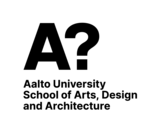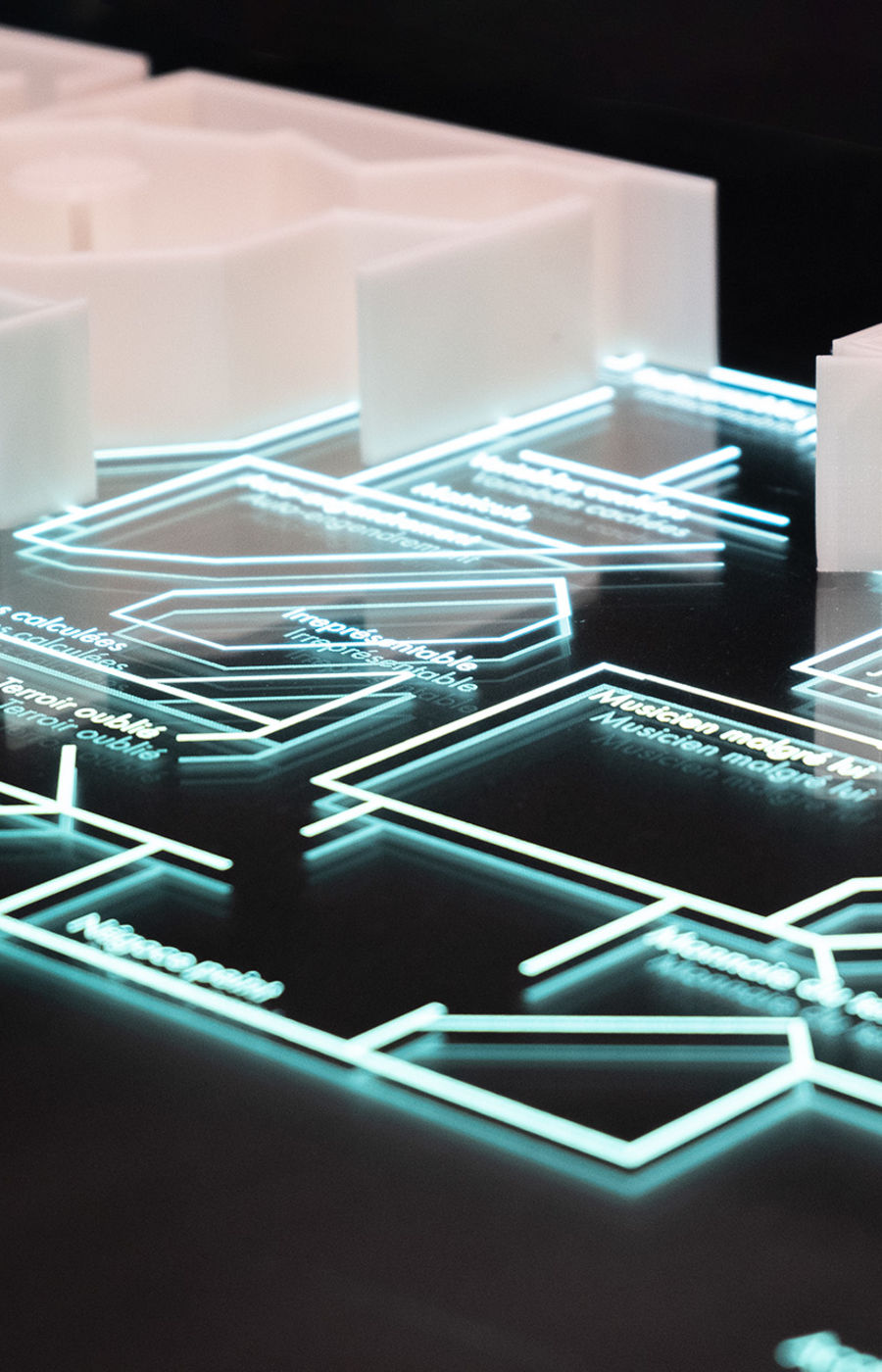
Heritage as a source of knowledge in artistic research and design education
The exhibition revisits the site of Les Immatériaux, an exhibition curated in 1985 by Jean-François Lyotard and Thierry Chaput, showcasing an educational perspective to the Creative Europe research project Beyond Matter – Cultural Heritage on the Verge of Virtual Reality.
Dipoli Gallery, 2023
The exhibition revisits the site of Les Immatériaux, a 1985 milestone ‘manifestation’ curated by French philosopher Jean-François Lyotard and design theorist Thierry Chaput which explored an epistemological turn brought on by new computational technologies that will transform society and human relationship with the world.
The exhibition showcases an educational perspective to the research project Beyond Matter – Cultural Heritage on the Verge of Virtual Reality encapsulated in the MA Fellowship Programme. The artistic assessment of the Programme lets us reflect on the complexities and advantages of transformative co-design collaborations as a potent direction for practice-based art and design research. In the interdisciplinary context of digital cultural heritage, it addresses the potential that designers and artists have in bridging different domains.
This exhibition highlights selected aspects of engaging with heritage and displays processes and outcomes of co-design methodologies employed during the Beyond Matter MA Fellowship Programme in particularly rich and insightful collaboration between Aalto University and the Centre Pompidou. Throughout this interdisciplinary experiment resulting in the concept design for The Virtual Exhibition of Les Immatériaux, designers, curators and art historians worked closely together and generously shared their knowledge to build a common space of inspiration and understanding.
Exhibition Dates: 22.09-23.11.23 / Mon-Thu: 8:00–20:00 / Fri: 8:00–18:00 / Sat-Sun: Closed / Location: Dipoli Gallery, Otakaari 24, 02150 Espoo / Aalto University
Many hands and minds have contributed to the research, thinking, learning and material and immaterial outcomes that are part of this exhibition.
Please see a list of contributors and acknowledgements here.
Exhibited Works
1. Anatomy of the Beyond Matter MA Fellowship Programme (2023) by Cvijeta Miljak
2. Re-matter: Five Sites of Departure (2022) by Cvijeta Miljak*
3. Octave au pays des Immatériaux (1985), by Paule Zajdermann, Kandinsky Library, Centre Pompidou
4. Un-time: Machinima Printed Matter (2022) by Lily Díaz-Kommonen*
5. Orbiting Specimens – Archival Placeholders (2022) by Cvijeta Miljak*
6. The Virtual Exhibition of Les Immatériaux (2022) by Beyond Matter
7. Archival transformations (2022) by Niklas Alenius
8. Shadowgram of Spiderman (1985) by Lily Díaz-Kommonen
9. Beyond Matter, Within Space (2023) Edited by Lívia Nolasco-Rózsás, Marianne Schädler
* Works in the exhibition use various elements created during the concept design phase by MA Fellows Niklas Alenius, Punit Hiremath, Edoardo Piroddi and Jiaxin Tao, as well as archival material from Kandinsky Library. For full credits please check The Virtual Exhibition of Les Immatériaux
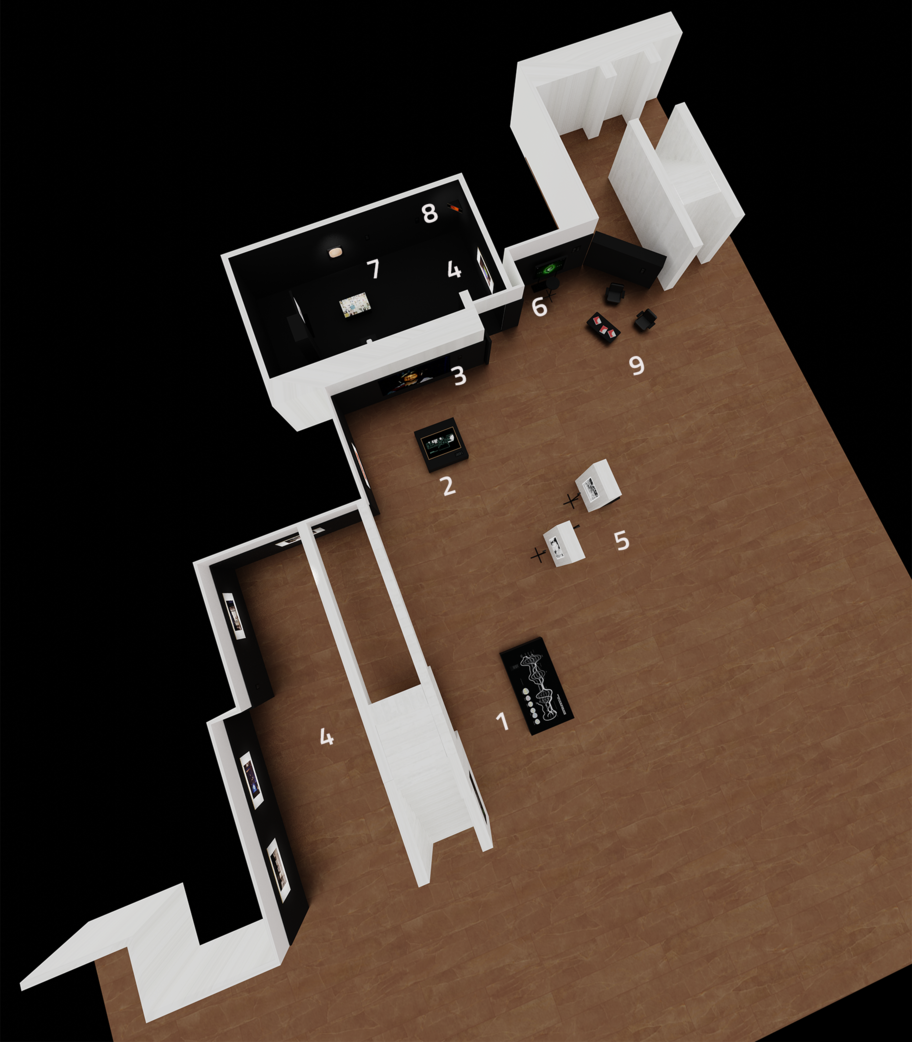
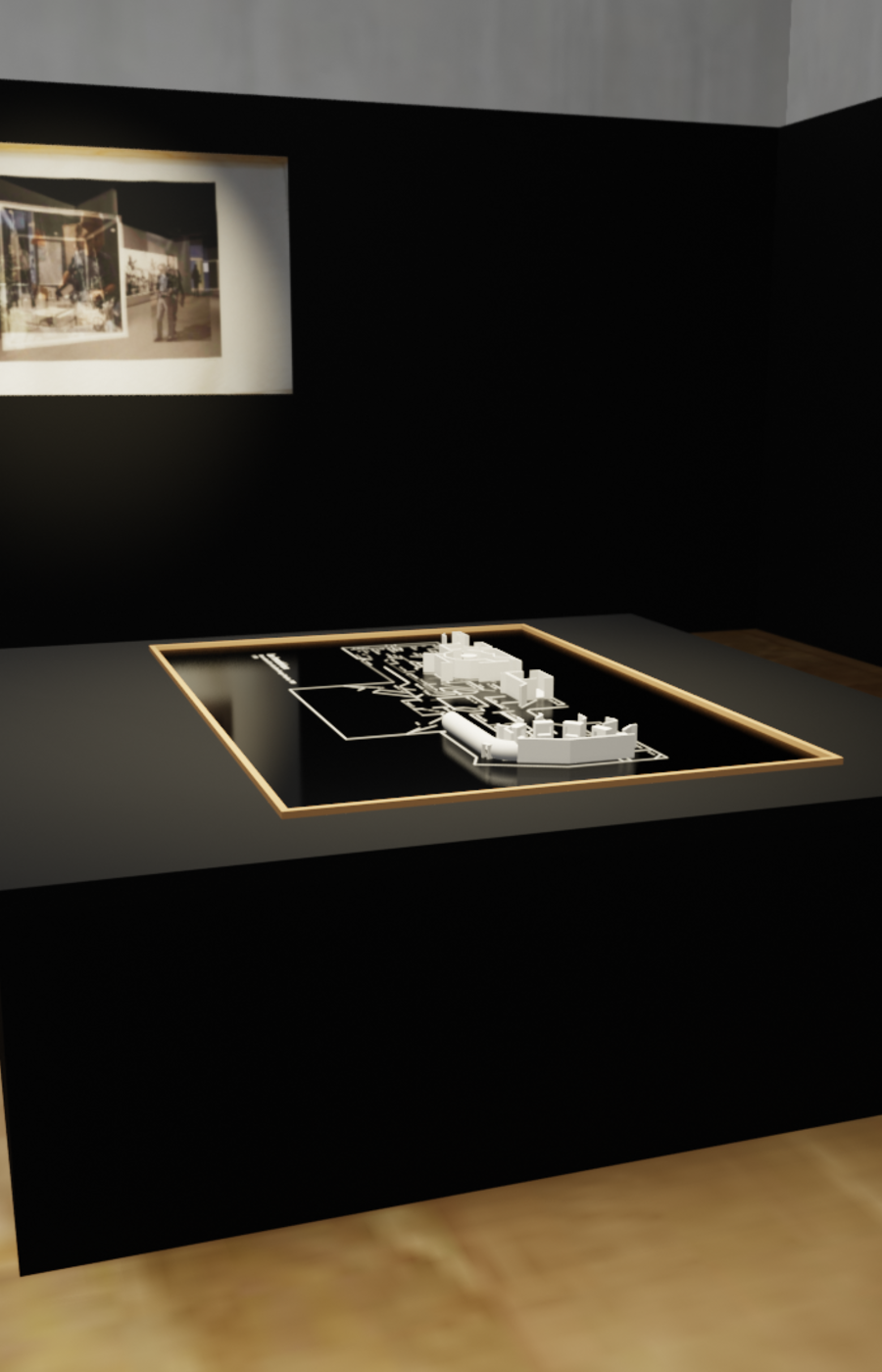
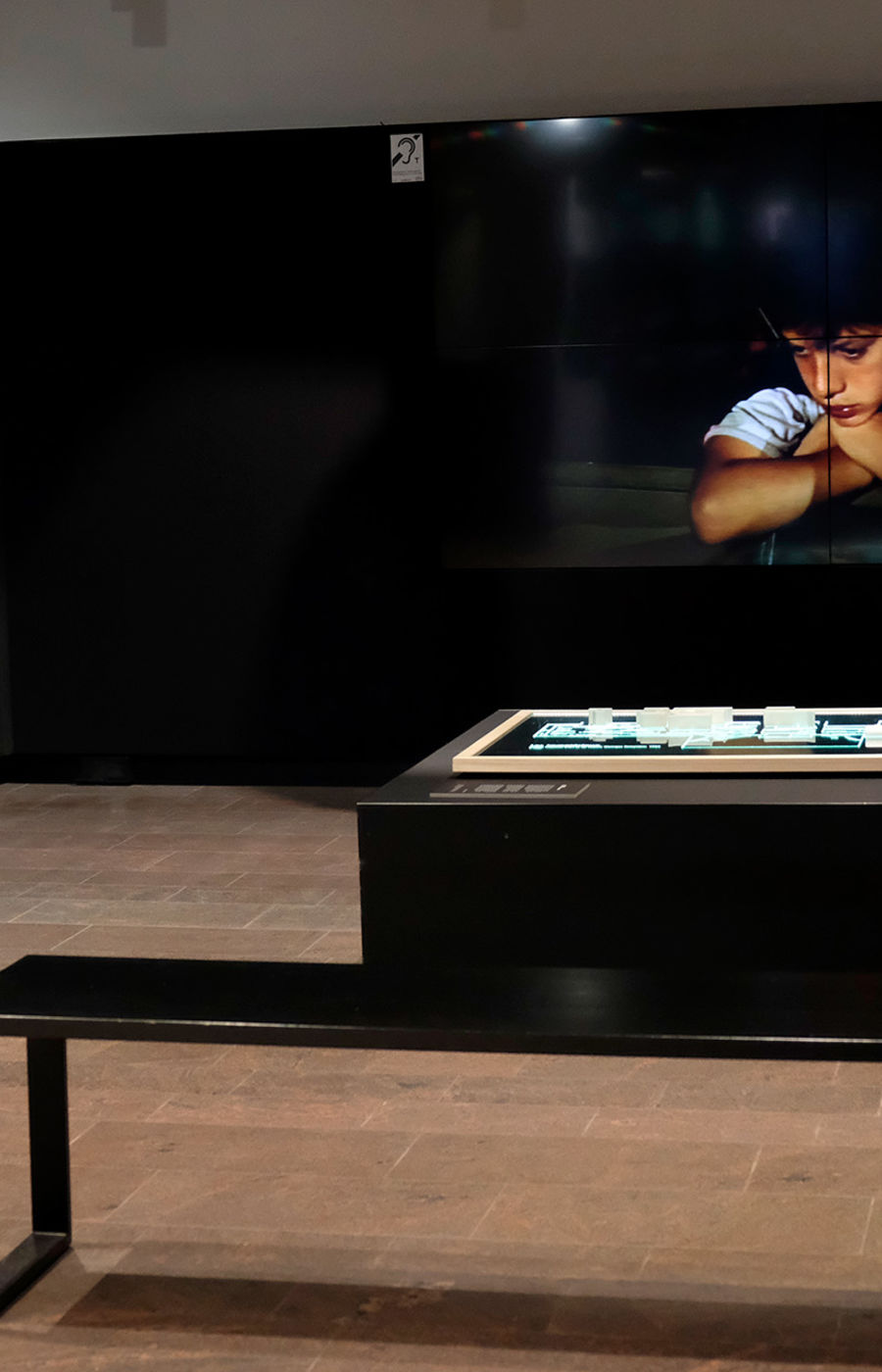
Gestures in time-space where knowledge can be forged anew - reflections on Beyond Matter, Cultural Heritage on the Verge of Virtual Reality
As with human knowledge all around us, heritage exists and is distributed through our tangible and intangible cultural practices: As we study ancient Roman buildings, we marvel at their resilience extolling the virtues of past techniques. Similarly, we are astonished when we read about the use of medicinal herbs by traditional societies in the Amazon. Consider the jagged dance of gestures unfolding, as the cement was laid to build the Roman roads that we now study to learn “how did they do it?” Or when we witness the reenactment of an oral tradition, where a plant disentangled from its surrounding is brought into new combinations with other substances that bring relief.
The study of heritage includes investigation and analyses of tangible (designed) artefacts including monuments and archival materials, such as exhibitions and works of art. It also comprises of intangible heritage research and studying the folklore and traditions as well as language, among others. It could be argued that at the core, these reenactment activities often involving simulation, propitiate an exchange where knowledge – old and new – is developed, preserved, and passed on.
Les Immatériaux was a landmark 20th Century event held at Centre Pompidou in Paris. Combining multimedia technologies with dramaturgy, the exhibition brought together art, design, science, technology, and commerce. Yet thirty-four years after it closed, very few memories remained. Using new media technologies and through our work at Aalto University we aimed to provide the curators and archivists with new digital spaces enabling virtual perambulations that would, hopefully, augment both intellectual and sensual perceptions. Perhaps there would come moments when mind and body would fuse into new revelations.
At the core, the exhibition here at Dipoli is but a sample of the re-enactments and ponderings occurring throughout the four-year duration of the Beyond Matter, Cultural Heritage on the Verge of Virtual Reality. I think these resulted in processes that brought into play questions of how to create expansive gestures in time-space where knowledge can be forged anew. I take this opportunity to thank all our Aalto students as well as our colleagues who participated in the project for their integrity, sense of ethics and foremost, boundless joy and spirit of creativity.
Lily Díaz-Kommonen is a Professor in the Department of Art & Media and Principal Investigator, Beyond Matter Project, Aalto University
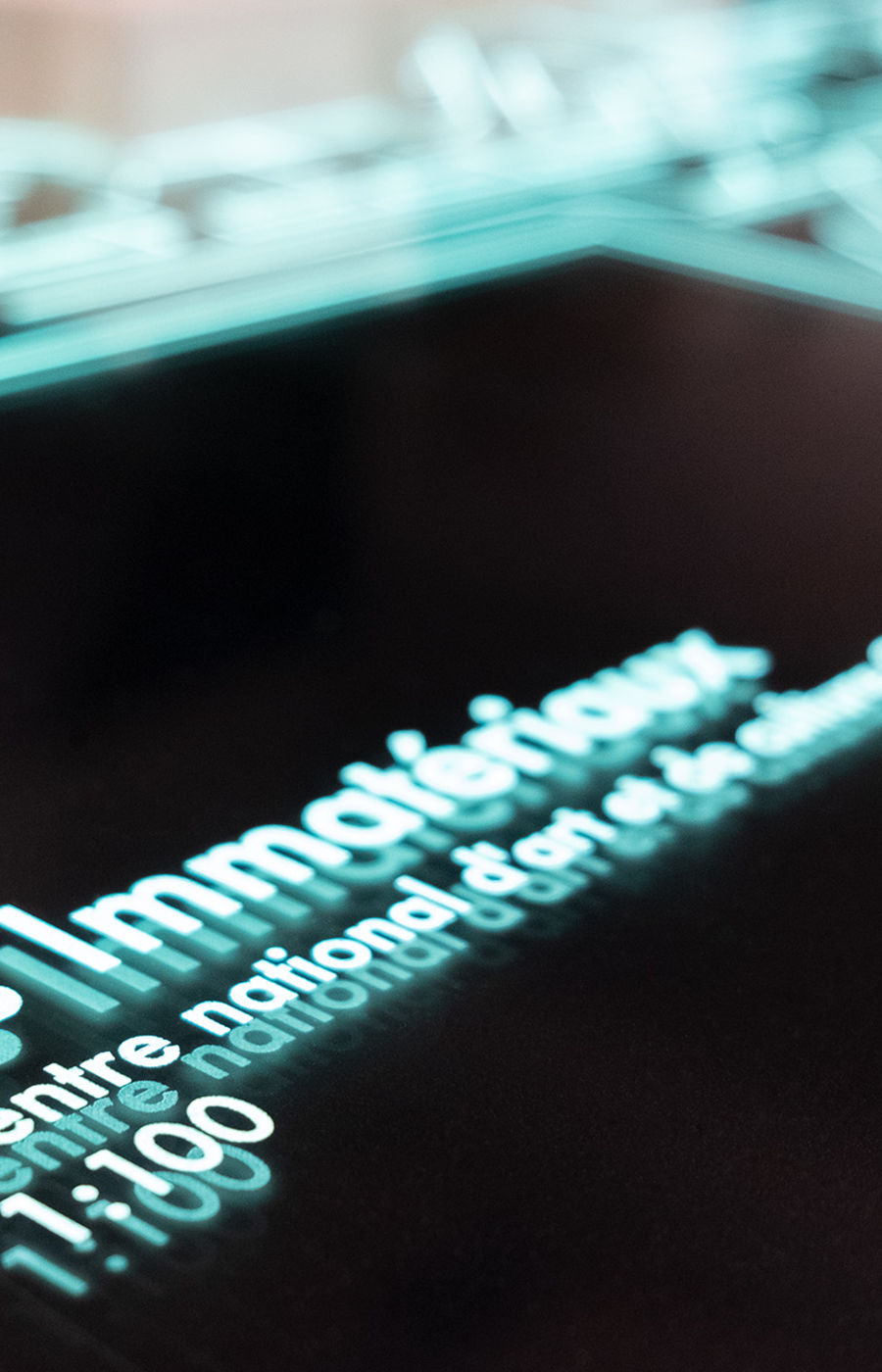
Explore the exhibition
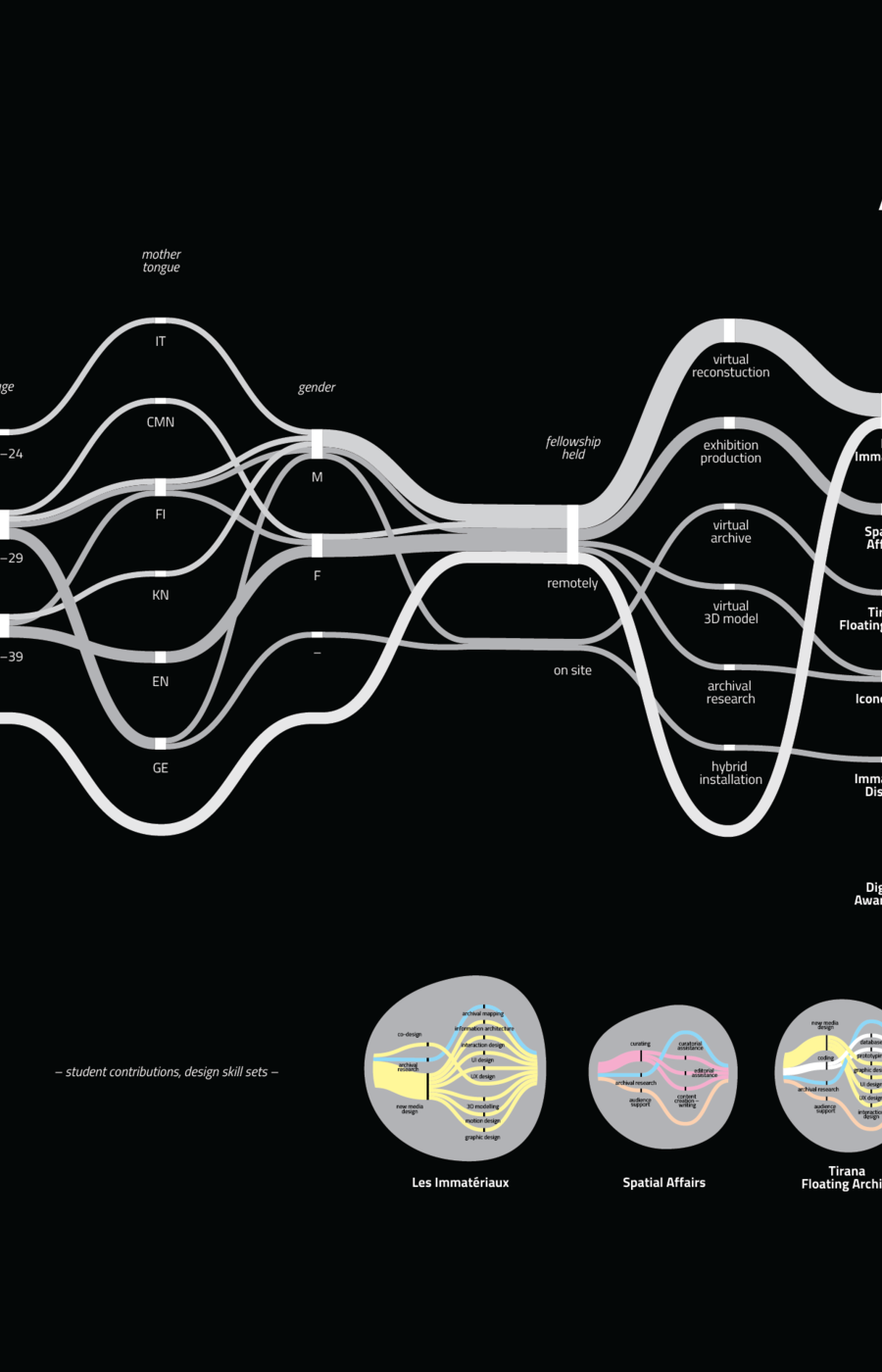
ANATOMY OF THE BEYOND MATTER MA FELLOWSHIP PROGRAMME
The MA Fellowship Programme was coordinated from autumn 2020 to summer 2021, in the context of the Beyond Matter project, concurrently with the conceptual phase of the digital reconstructions of two momentous historical exhibitions, Les Immatériaux (Centre Pompidou, 1985) and Iconoclash (ZKM, 2002). The MA Fellowship Programme offered internships at four different European cultural heritage institutions to ten outstanding students selected through an application process open to the Aalto University MA students of all study lines.
The work, which the students completed during their fellowships, ranges from contribution to production process of a physical exhibition and an online conference, involvement with curatorial concepts and research of archival materials, through creating 3D virtual models and interactive 3D web-based environments, developing interaction concepts for a hybrid exhibition, developing the concept design for online and mobile versions of a visual archive on public art, to a concept design for a virtual reconstruction of a historical exhibition.
The infographic shows the student demographics, the practice-based research design collaboration settings, as well as maps the student contributions and design skill set per project.
– Cvijeta Miljak, 2023
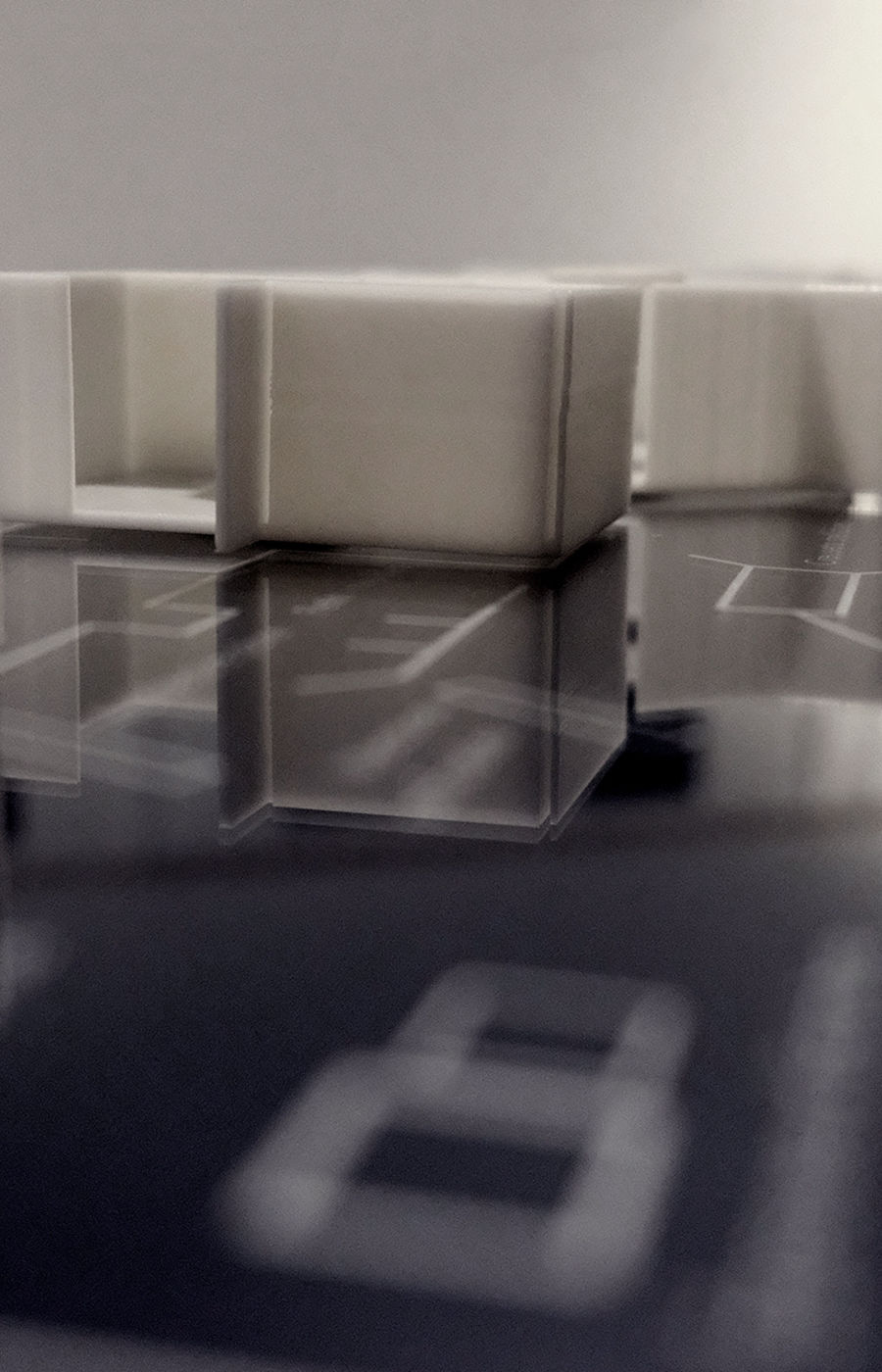
RE-MATTER – FIVE SITES OF DEPARTURE
A diagrammatic floor plan of Les Immatériaux, consists of sixty-five individual labyrinthically interconnected sites. It occures as a starting point for explorations into the archival material, leading to the virtual reconstruction of the exhibition. The spatial virtual 3D model enabled discoveries regarding the placement of certain exhibits, which was previously impossible because of the fragmentary documentation.
The research process leading to the final concept design started with five sites: Théâtre du non-corps, Matériau dématérialisé, Peinture luminescente, «Inframince» and Toutes les copies, selected for the diversity of the exhibits and the archival material they contained.
Exploring, understanding and imagining a trajectory from a bygone exhibition and the archival materials left behind, towards an interactive virtual experience of a digital reconstruction takes a tangible shape through digital fabrication techniques of laser engraving and 3D printing inspired by architectural scale models – maquettes – built to communicate the cornerstones of the design process.
– Cvijeta Miljak, 2023
Works in the exhibition use various elements created during the concept design phase by MA Fellows Niklas Alenius, Punit Hiremath, Edoardo Piroddi and Jiaxin Tao, as well as archival material from Kandinsky Library. For full credits please check The Virtual Exhibition of Les Immatériaux credits.
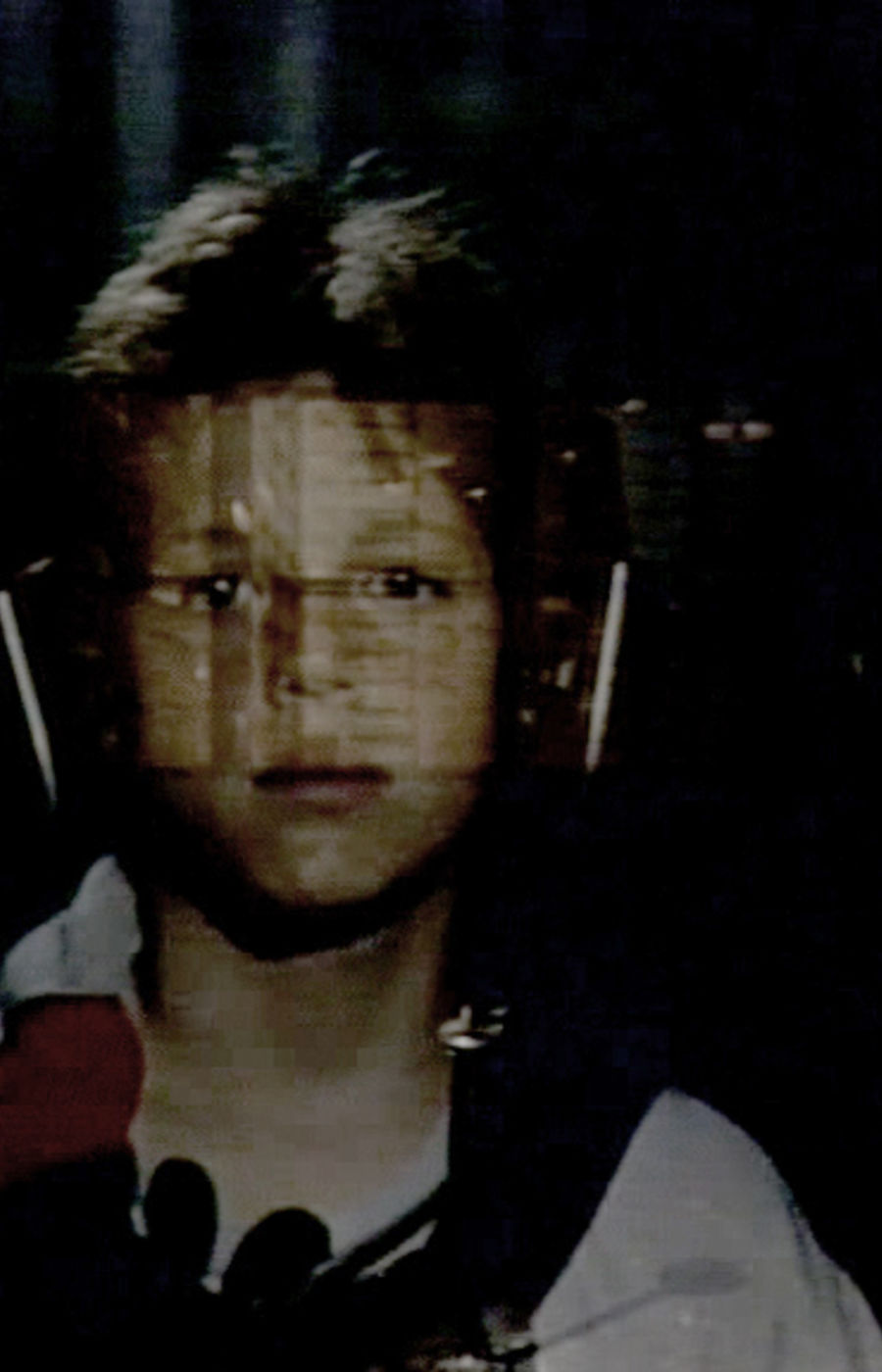
OCTAVE AU PAYS DES IMMATÉRIAUX
The documentary film Octave in the Land of Immaterials (35 min), with participation of Jean-Paul Lyotard and Thierry Chaput, features a young boy Octave navigating through the original exhibition on roller skates.
– direction by Paule Zajdermann, screenplay by Daniel Soutif and Paule Zajdermann, production Centre Pompidou, Kandinsky Library, 1985
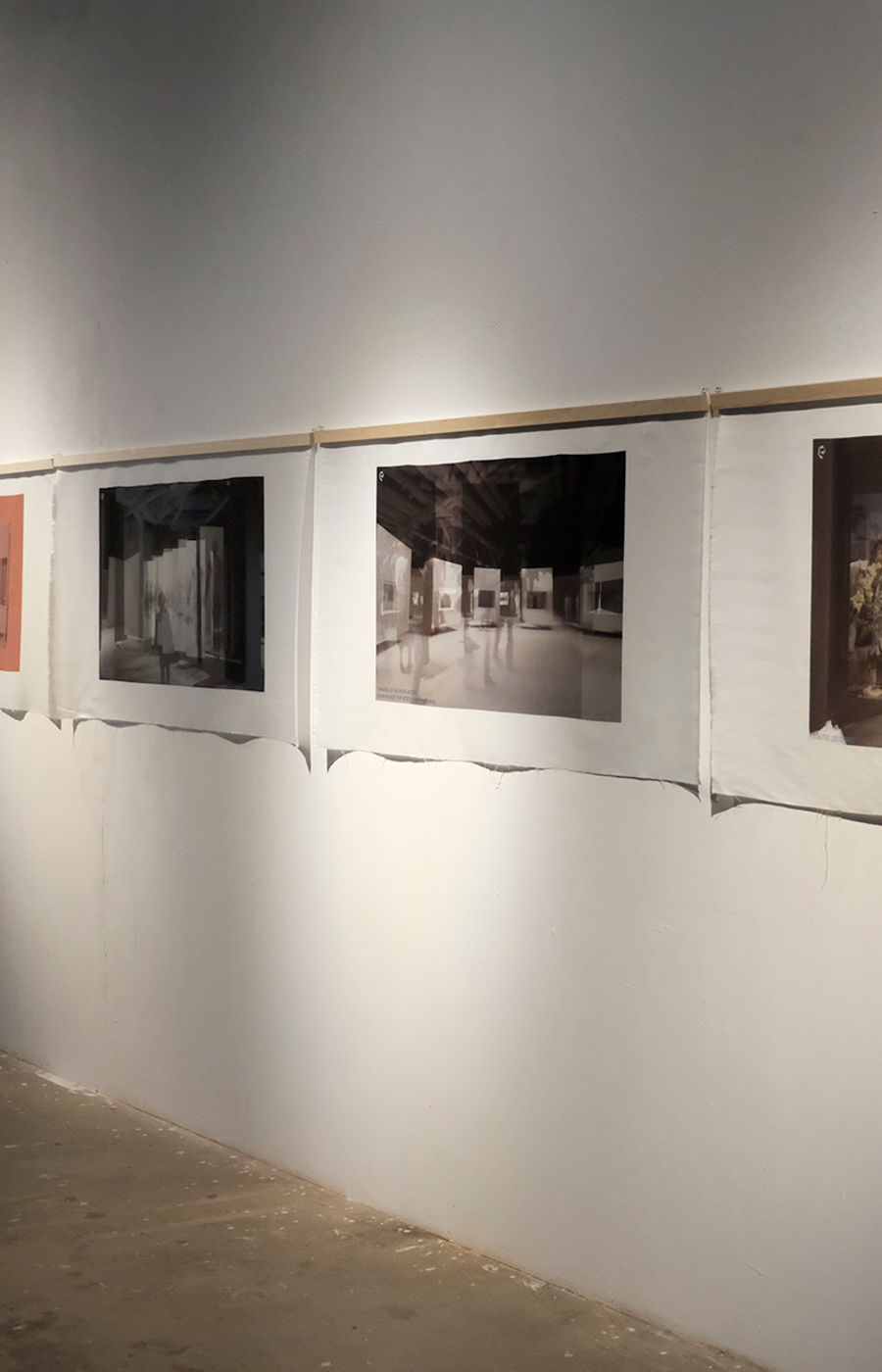
UN-TIME: MACHINIMA PRINTED MATTER
Machinima is an audio-visual genre that has emerged from games. Through machinima, people enact their own actions and activities in digital – often online – spaces which they then instantiate as films, or as in this case as Printed Matter literally encrusted on satin cloth material.
The six prints on exhibition offer the spectator a view from inside the novel 3D reconstruction model of the 1985 Les Immatérieaux exhibition created as part of the Beyond Matter – Cultural Heritage on the Verge of Virtual Reality.
The sights presented are complemented by archival materials from the exhibition. These images can be best described as time warp depictions: They are future-oriented projections that also remediate the past. The work is a commentary on contemporary digital culture as it becomes more and more entangled with the new digital spaces instantiated via information technologies such as AR, VR, XR.
– Lily Díaz-Kommonen, 2022
Works in the exhibition use various elements created during the concept design phase by MA Fellows Niklas Alenius, Punit Hiremath, Edoardo Piroddi and Jiaxin Tao, as well as archival material from Kandinsky Library. For full credits please check The Virtual Exhibition of Les Immatériaux credits.
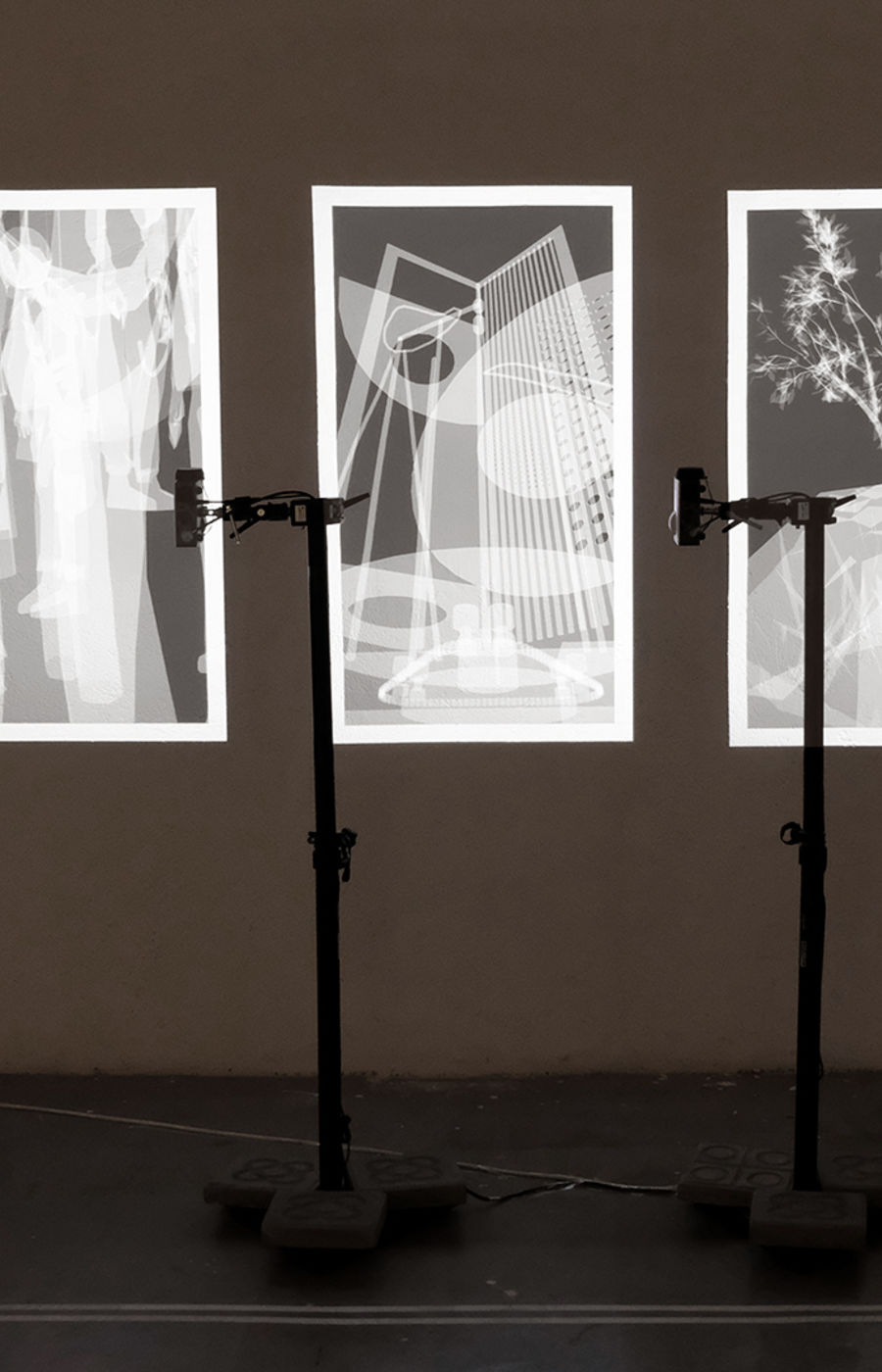
ORBITING SPECIMENS – ARCHIVAL PLACEHOLDERS
Three videos contemplate on the intersection of art, science and technology, an area of exploration in the past Les Immatériaux exhibition. Each video showcases a 3D model of one representative artefact from each field. Created for the virtual reconstruction, the 3D models serve as placeholders for the related archival materials.
The videos are rendered using a particular cinematic technique – the arc shot. The technique allows creating a sense of fluidity and movement in space and time to otherwise static scenes and focusing viewer’s attention to the subject with a constantly changing perspective. This can bring dramatic and poetic qualities to a visual experience of an object. The term ‘arc’ comes from mathematics and refers to a segment of a full circumference of a circle. This segment in the shot is the orbital path of the camera.
The work concerns the notion of translation from one medium to another. The videos remediate the 3D models from sites of Toutes les peaux (matrice), Peinture luminescente (matériau) and Irreprésentable (matière).
– Cvijeta Miljak, 2022
Works in the exhibition use various elements created during the concept design phase by MA Fellows Niklas Alenius, Punit Hiremath, Edoardo Piroddi and Jiaxin Tao, as well as archival material from Kandinsky Library. For full credits please check The Virtual Exhibition of Les Immatériaux credits.
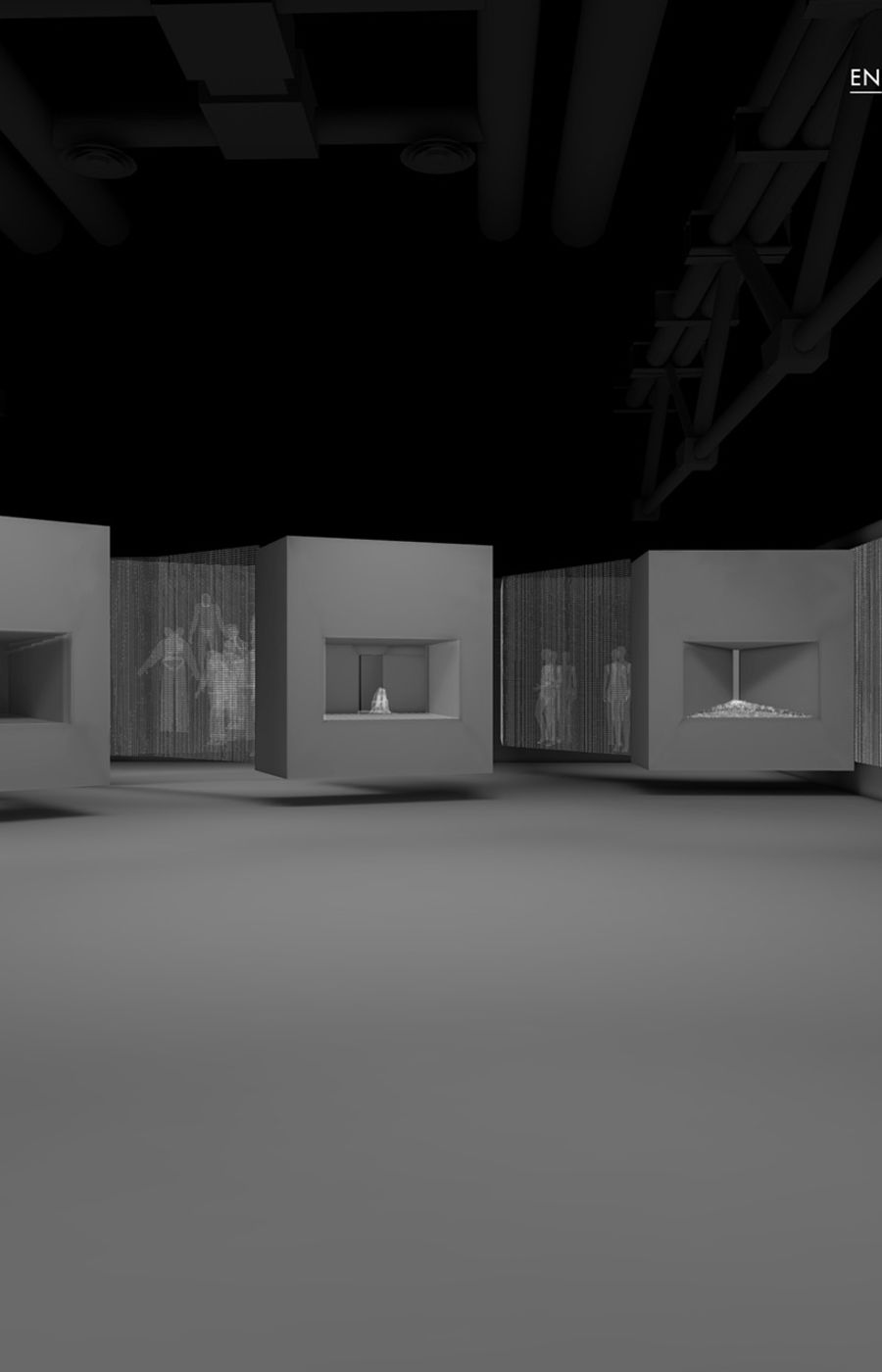
THE VIRTUAL EXHIBITION OF LES IMMATÉRIAUX
This virtual exhibition offers a systematic insight into the archives of the Centre Pompidou, and is a fruit of three years of research including an oral history project on ‘Les Immatériaux’. Along with digitalised versions of the soundtracks, a 3D model of the exhibition has been designed which, although not an exact reproduction, reflects the original architecture and scenography. Within the model, artworks and other exhibits appear in various modes of transparency, following a visual code that serves to indicate what is known about them today. Each of the exhibition’s sixty-five sites and some one hundred and fifty works, devices and objects exhibited are documented by a range of photographs and archives, descriptions and contextualisations.
- This text is taken from the Beyond Matter Les Immatériaux website
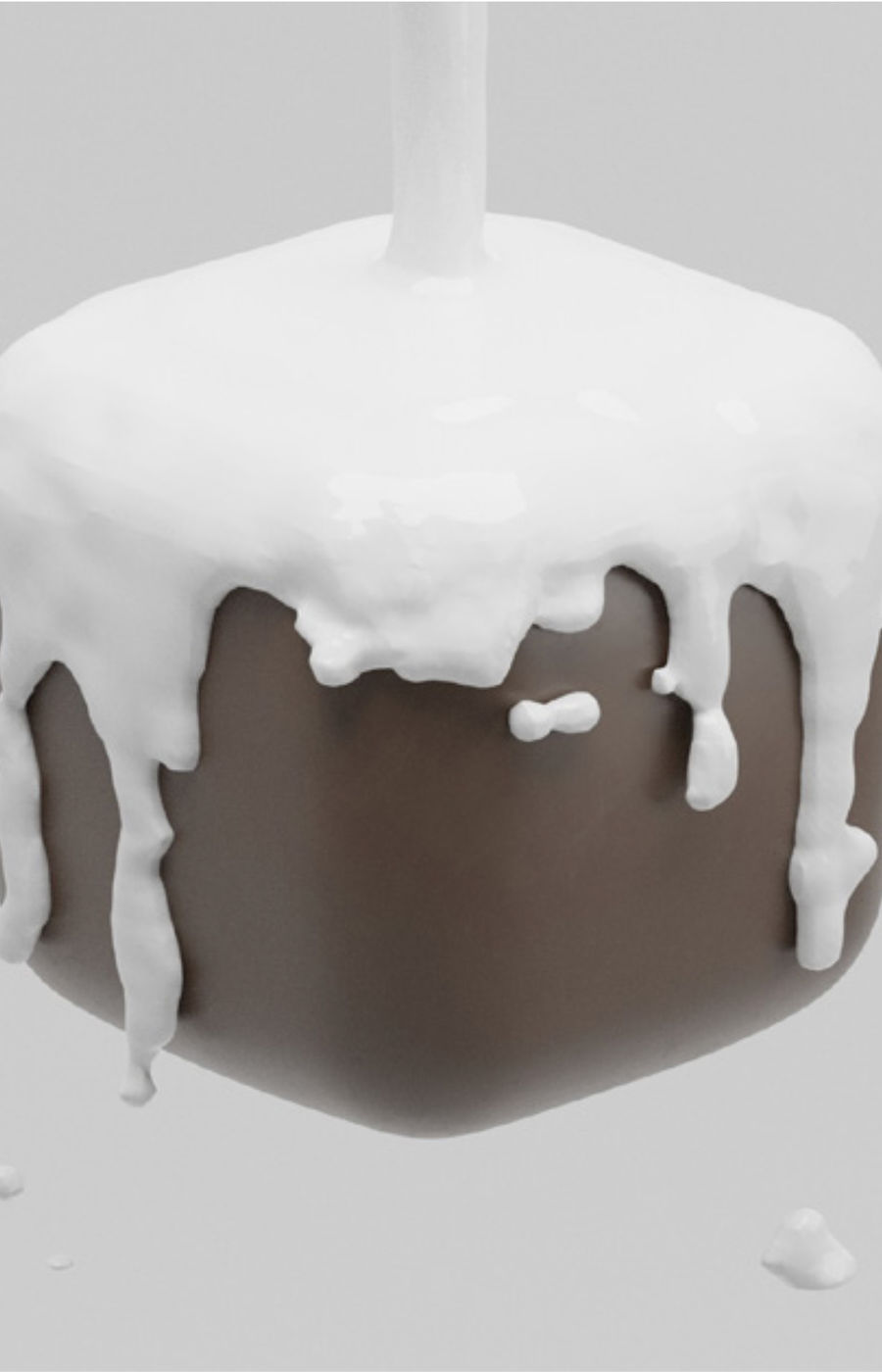
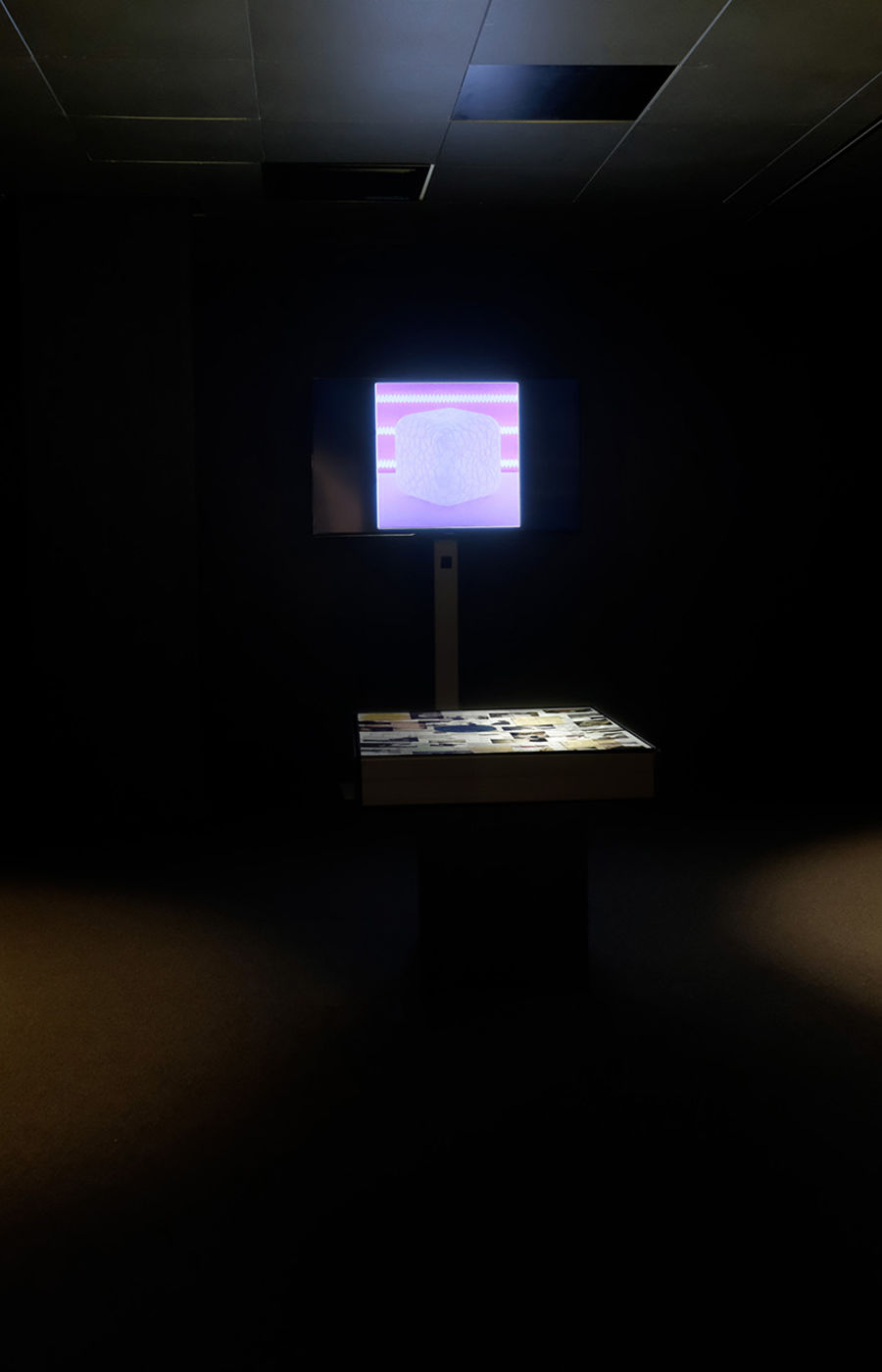
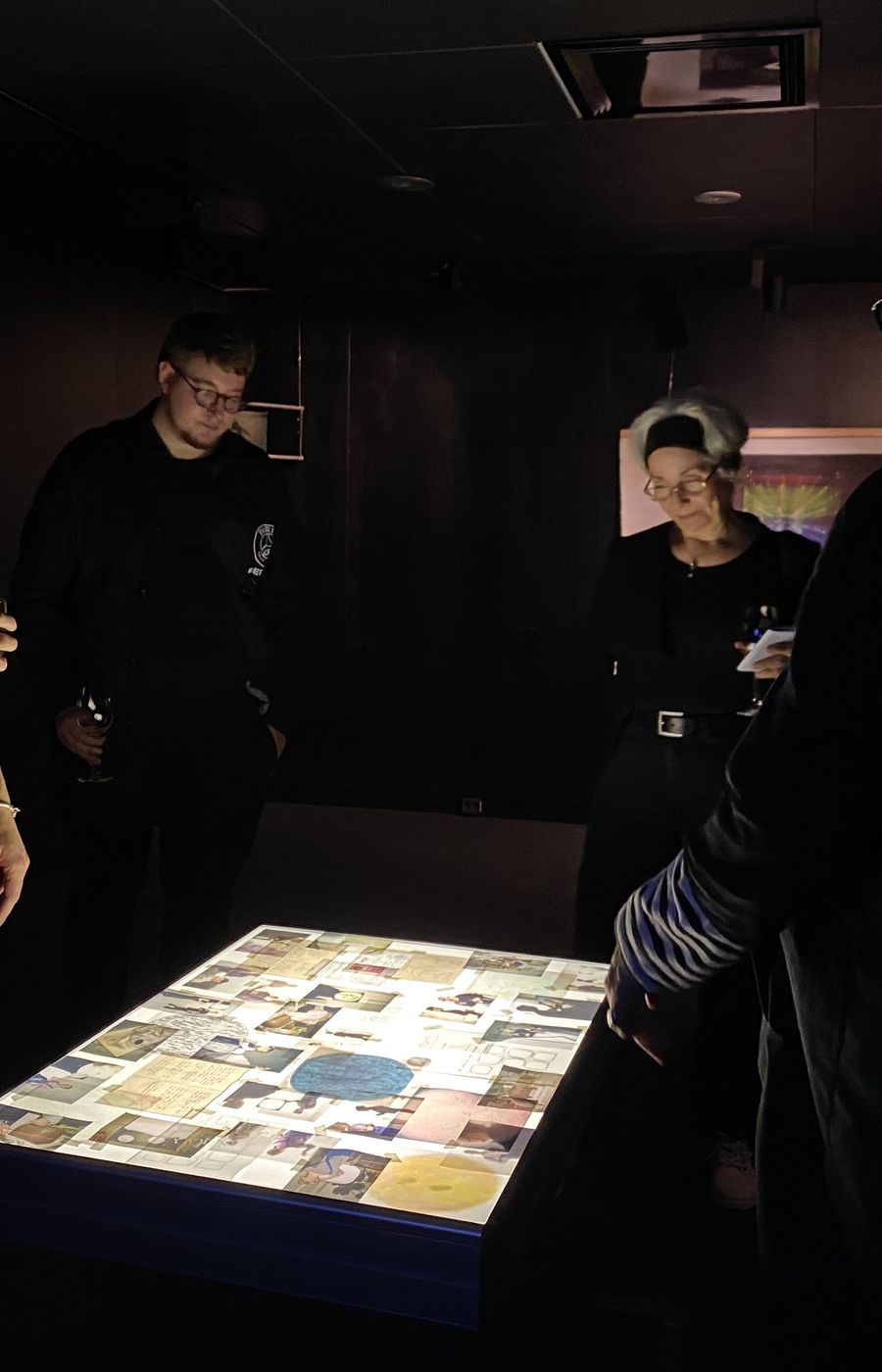
ARCHIVAL TRANSFORMATIONS - TRANSLATING SIMULATED ARCHIVES INTO DIGITAL 3D MEDIA
Personal working experience on the virtual reconstruction of Les Immatériaux exhibition, during the MA Fellowship Programme, served as an anchor for this MA thesis work, which explored the notion of archiving art in the current age of digital media.
The outcome of the thesis, conducted as an artistic research project, is a narrative-driven creation of two objects that represents pieces of art and their transformation. An oil painting and a ceramic sculpture, designed and fabricated as the basis for exploration are first converted into archives and subsequently translated into a digital medium. The result is a virtual interpretation of the original objects, utilizing archival information as the foundation.
The project reflects upon the research question: How to translate archived information about physical artefacts into the digital 3D media? By exploring the notion of archives, the project invites the audience to contemplate the boundary between speculative and justified. The result is a story of two objects – illustrating their transformation from physical to virtual, bounded by archival information.
– Niklas Alenius, 2022
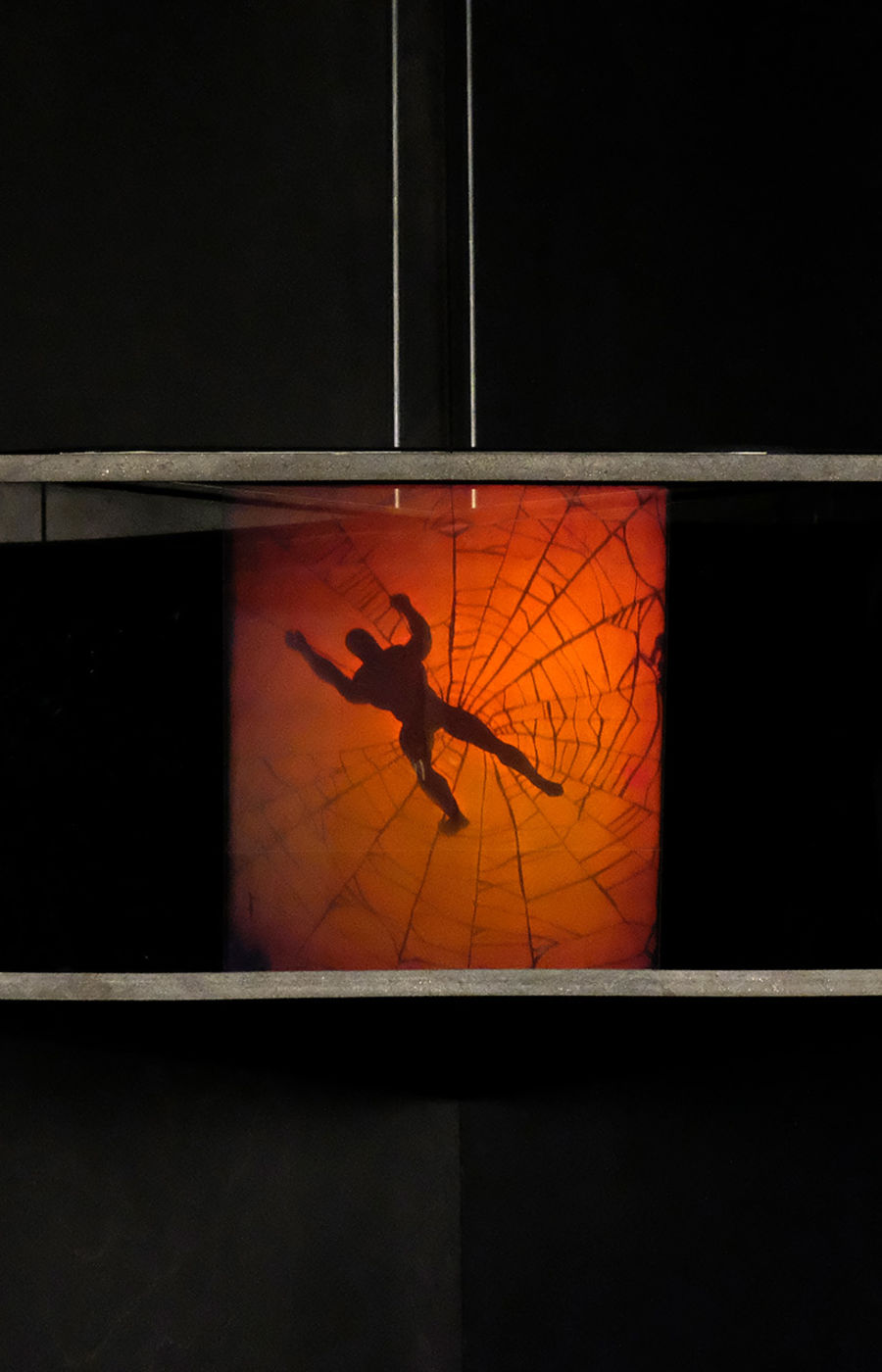
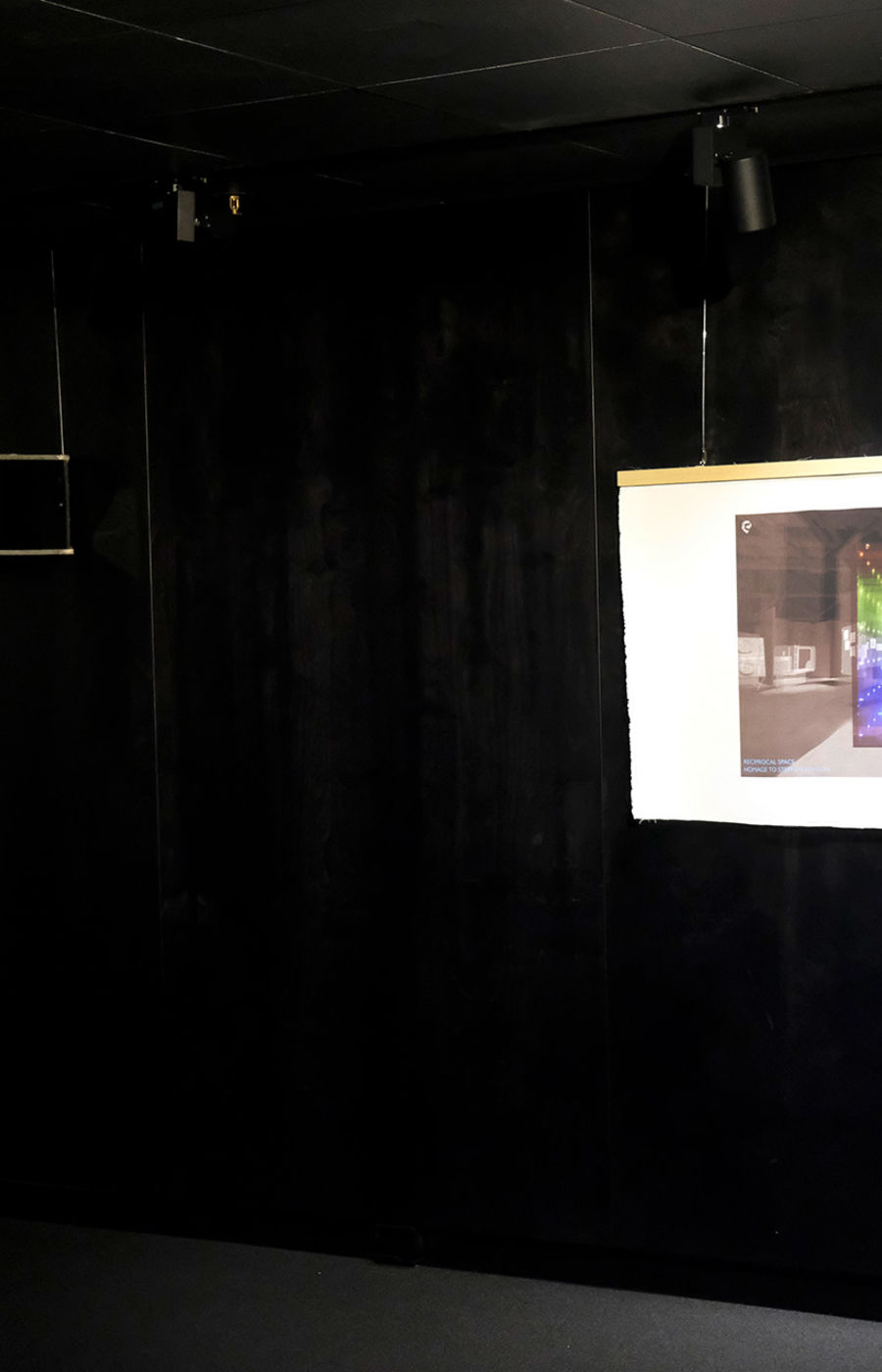
SHADOWGRAM OF SPIDERMAN
The Shadowgram of Spiderman is a reflection hologram printed on a 20.3 X 25.4 photosensitive glass plate. The work was realized at the Museum of Holography in New York City in 1985 during a competitive artistic residency period intended to offer education about the medium.
The artist worked with Fred Unterseher, a pioneer holographer, educator and artist. The work is part of the collection of the MIT Museum.
– Lily Díaz-Kommonen, 1985
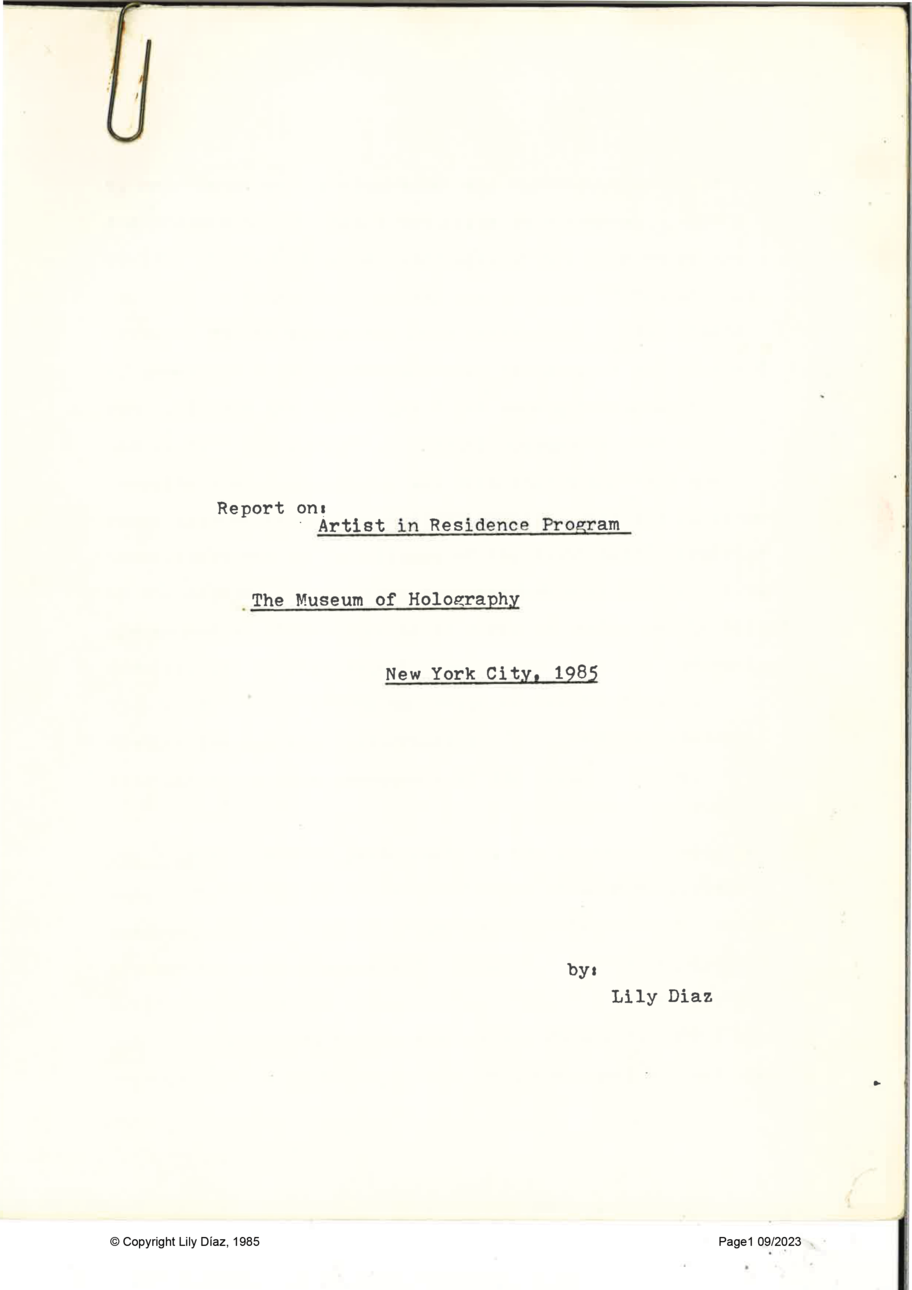
SHADOWGRAM OF SPIDERMAN
MUSEUM OF HOLOGRAPHY REPORT, NEW YORK, 1985
The Shadowgram of Spiderman work is a unique artwork in this exhibition in terms of it having its origins not in Paris and Les Immatériaux, but in the Museum of Holography in New York that same year of 1985. While it is not a work which was produced or reproduced as part of the Beyond Matter project, its significance lies in its parallel relation to this moment of cultural production in new media. Its inclusion provides context for educational perspectives, in particular, the role of organisational resources and mentorship in developing possibilities for experimentation and emergent practices in artistic research.
The translucency of the compact, glass materiality of the work belies its own rich strata of archival matter. This report is shared by the artist as a document of the material conditions of time, place, and people who provided the possibility to learn these new methods, the contours of which can be seen throughout her practice and artistic research.
The original report can be viewed here - copyright Lily Díaz-Kommonen, 1985
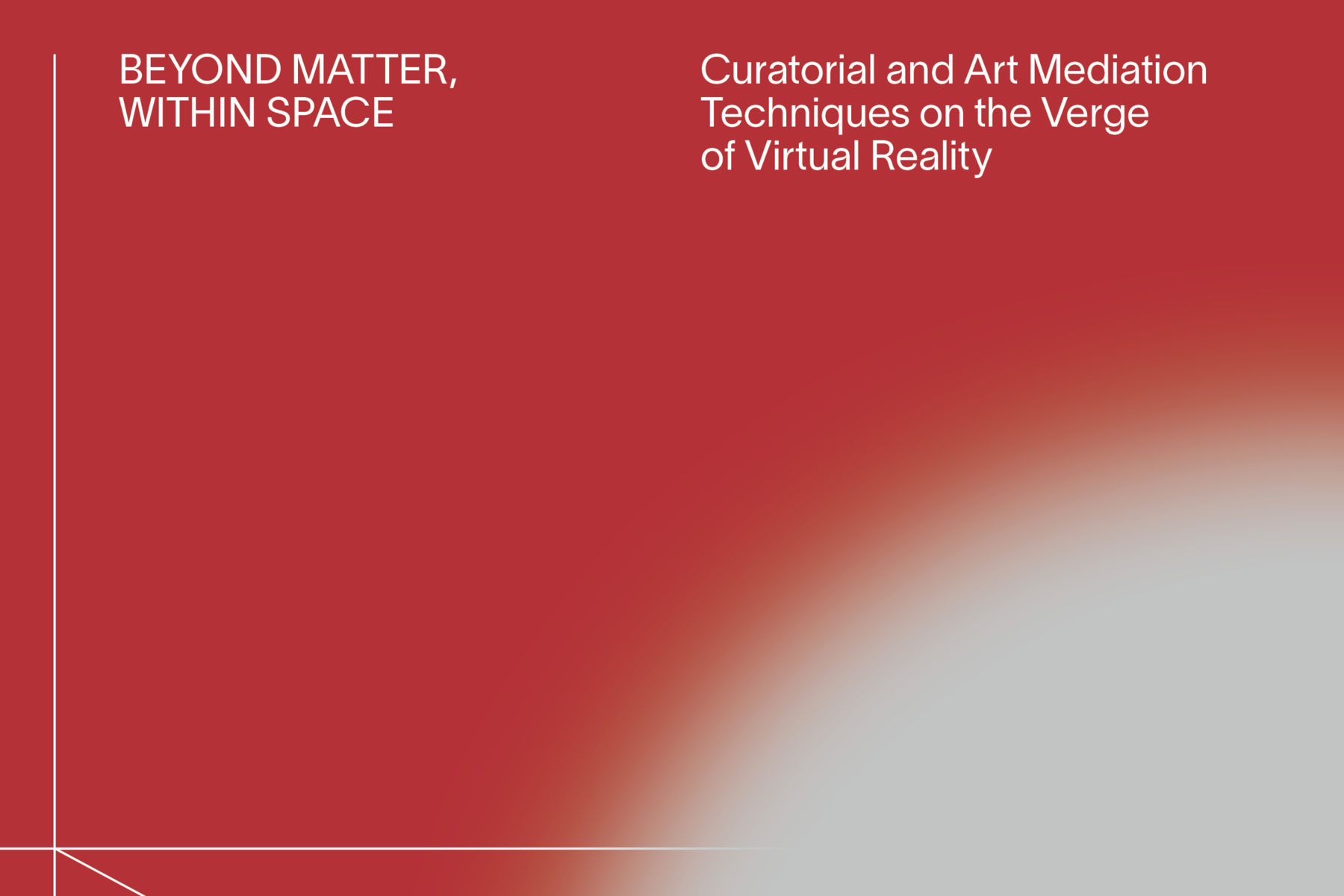
BEYOND MATTER, WITHIN SPACE: CURATORIAL AND ART MEDIATION TECHNIQUES ON THE VERGE OF VIRTUAL REALITY
Exhibitions are sites of knowledge production and exchange, and their spatial qualities are central to contextualizing the information harbored within the artworks they present. In virtual emulations of exhibitions, immersion is not bound to geographical location but to the interplay between materiality and representation. Bringing together partners from around and beyond Europe, the research project Beyond Matter (2019–23) aimed to make sense of the interdependence between physical and virtual and to decipher the impact of that interdependence on the spatial aspects of producing, curating, and mediating art. In exploring the so-called virtual condition, the project proposed new modes for preserving cultural heritage while probing the potentials of digital world-making.
This publication offers a comprehensive overview of the multifaceted research activities conducted by the Beyond Matter partners and takes a deeper look at the enfoldments of virtual reality. In interviews, scholarly essays, and other texts, the authors document the project outcomes and expand on its theoretical foundations.
Edited by: Lívia Nolasco-Rózsás, Marianne Schädler
Authors: Paul Aguraiuja, Ali Akbar Mehta, Kristaps Ancāns, Corina L. Apostol, Constança Babo, Amanda Beech, Philippe Bettinelli, Giulia Bini, Andreas Broeckmann, Julie Champion Lagadec, Annet Dekker, Adela Demetja, Lily Díaz-Kommonen, Krischan Ditsch, Dennis Dizon, Jan Elantkowski, Irmgard Emmelhainz, Elena Esposito, Fruzsina Feigl, Bernard Dionysius Geoghegan, Marialaura Ghidini, Jiří Gruber, Esteban Gutiérrez-Jiménez, Graham Harman, Kai-Uwe Hemken, Yannick Hofmann, Johanna Jolen Kuzmenko, Borbála Kálmán, Helen Kaplinsky, Sebastian Klein, Felix Koberstein, Bogna Konior, Moritz Konrad, Sybille Krämer, Laura Kuusk, Camille Laurelli, Marcella Lista, Anna Longo, Elen Lotman, Mauro Martino, Cvijeta Miljak, Daria Mille, Felix Mittelberger, Lívia Nolasco-Rózsás, Elena Papadaki, Christiane Paul, Anastasia Philimonos, Siim Preiman, Cecilia Preiß, Simon Schneebiegl, Gaia Tedone, Amanda Tristão Parra, Annette Urban, Marie Vicet, Kim West, Siegfried Zielinski
Interviews with: Beatrice von Bismarck, Zach Blas, Enrico Boccioletti, Janine Burger, Donika Çina, Ami Clarke, Dennis Dizon, Jazmina Figueroa, HUNITI GOLDOX, Hanna Hildebrand, Carolyn Kirschner, Olson Lamaj, Valentina Peri, Theodoulos Polyviou, The Rodina, Beatrix Szörényi, Alexander Walmsley
- This text is taken from https://beyondmatter.eu/news/beyond-matter-within-space-curatorial-and-art-mediation-techniques-on-the-verge-of-virtual-reality
Link to the ebook: https://withinspace.beyondmatter.eu/
Hardcopy of the publication can be ordered through ZKM webshop: https://webshop.zkm.de/Beyond-Matter-Within-Space
CREDITS
-
HERITAGE AS A SOURCE OF KNOWLEDGE IN ARTISTIC RESEARCH AND DESIGN EDUCATION - DIPOLI GALLERY 2023
Exhibition team, Dipoli Gallery
Lily Díaz-Kommonen, Professor, Department of Art & Media, School of Arts, Design and Architecture
Cvijeta Miljak, Doctoral Researcher, Department of Art & Media, School of Arts, Design and Architecture
Edel O’ Reilly, Curator, Aalto Exhibitions
Exhibition concept
Cvijeta Miljak and Lily Díaz-Kommonen
Exhibition, graphic design and photography
Cvijeta Miljak
3D models
Niklas Alenius, Jiaxin Tao
Thank you
Janne Andberg, Solomon Embafrash, Juri Lahelma, Alejandro Martin, Janne Ojala, Pasi Pakula, Laura Törnroos
Support
Aalto Printlab, Aalto Fablab, Aalto Takeout, Aalto Studios
-
BEYOND MATTER MA FELLOWSHIP PROGRAMME - CASE STUDY WITH CENTRE POMPIDOU
Aalto University School of Arts, Design and Architecture
Principal Investigator
Lily Díaz-Kommonen
Planning officer
Hanna Karkku
MA Fellowship coordinator
Cvijeta Miljak
Design Team
Niklas Alenius, Punit Hiremath, Edoardo Piroddi, Jiaxin Tao
Advising and supervision
Lily Díaz-Kommonen and Cvijeta Miljak
Centre National d’Art et de Culture Georges Pompidou
Curatorial team
Marcella Lista, Philippe Bettinelli, Julie Champion Lagadec
New Media Department, Musée national d’art moderne – Centre de création industrielle
Archival research
Andreas Broeckmann, Marie Vicet
-
THE VIRTUAL EXHIBITION OF LES IMMATÉRIAUX
Centre national d’art et de culture Georges Pompidou
Curatorial team: New Media Department, Musée national d’art moderne - Centre de création industrielle: Philippe Bettinelli, Julie Champion, Marcella Lista
Research: Andreas Broeckmann, Marie Vicet
Concept Design: Aalto University: Niklas Alenius, Punit Hiremath, Edoardo Piroddi, Jiaxin Tao, under supervision of Lily Diaz-Kommonen and Cvijeta Miljak
UI/UX design and 3D modelling:: Niklas Alenius, Edoardo Piroddi
Project Management and UI/ UX design adviser: : Matthias Heckel
Software Development: Netzbewegung GmbH
Author of the texts: Antonia Wunderlich, edited by Andreas Broeckmann
English translations: Andreas Broeckmann, Robin Mackay
Digitisation: Bibliothèque Kandinsky, Gecko – numérisation et restauration du patrimoine sonore
With the participation of the following departments at the Centre Pompidou:
Bibliothèque Kandinsky: Sonia Descamps, Mica Gherghescu, Nicolas Liucci-Goutnikov;
Audiovisual Department: Arnold Jeanville, Laetitia Poissonnier, Sylvain Wolf;
Public Archives:Jean-Philippe Bonilli, Jean Charlier
Special thanks to the people involved in Les Immatériaux in 1985, who kindly shared their memories and archives:
Bernard Blistène, Jean-Louis Boissier, Pauline Délis, François-Xavier Délis, Jacques Faujour, Frédéric Develay, Katia Lafitte, Françoise Michel, Martine Moinot, Jean-Claude Planchet, Philippe Puicouyoul, Daniel Soutif, Katerina Thomadaki, Liliane Terrier, Paule Zajdermann

